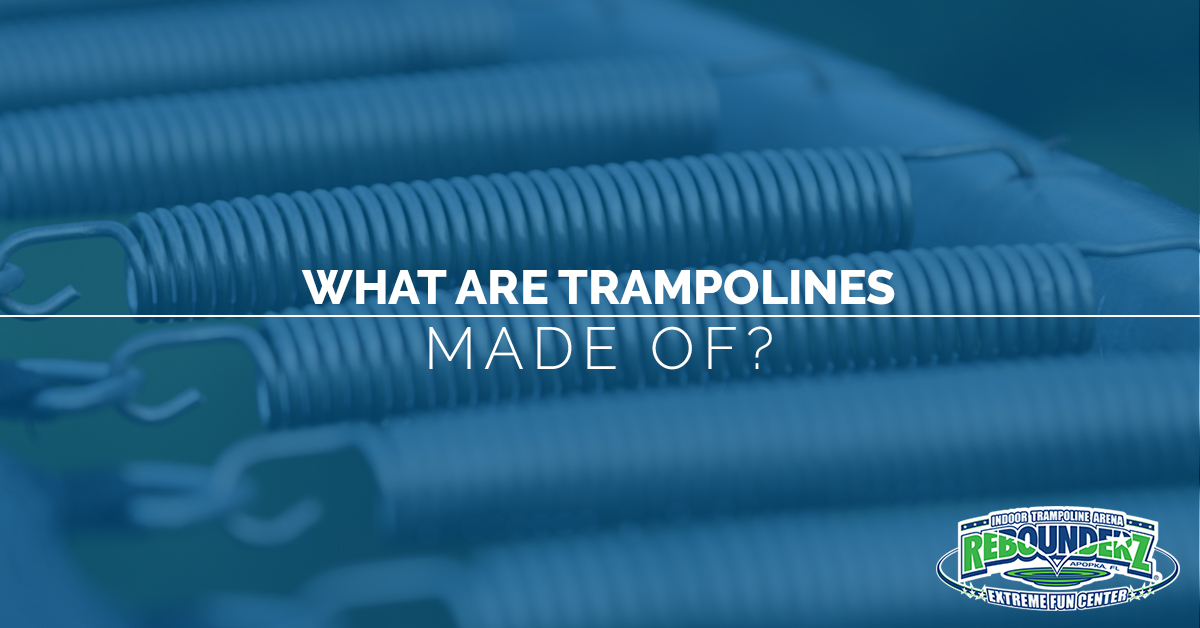ENJOY FREE ADMISSION EVERY DAY WHEN YOU PURCHASE A REBOUNDERZ MEMBERSHIP!

Call Us Now: (833) 832-1255
ENJOY FREE ADMISSION EVERY DAY WHEN YOU PURCHASE A REBOUNDERZ MEMBERSHIP!

Call Us Now: (833) 832-1255

When you bounce on a trampoline it is difficult to think of anything else. You are caught in the joy of bouncing in the air. But have you ever wondered what trampolines are made of? What specific pieces give trampolines that amazing bounce you love?
The Components
Trampolines are made with four basic components:
• Springs
• Tubing
• Safety Pads
• Canvas Fabric
Springs
The springs are what gives the trampoline bounce, not the canvas surface. Despite what many people think, the springs are responsible for the exertion you feel when you are launched into the air. However, five factors determine the strength of the spring.
• Material
• Galvanization
• Size
• Number
• Shape
Material: The material of the spring directly affects the power behind the springs. Almost all trampolines are constructed with metal. There are some backyard trampolines that use elastic bands to provide spring. However, elastic bands do not keep tension and thus, lose bounce potential over time.
Galvanization: Galvanization is when the spring is covered with a protective coat of zinc layering.. Zinc is much more resistant to corrosion than metals, like steel. By coating the springs with zinc, manufacturers can ensure that the spring will be sustainable for a longer period of time.
Size: The size of the springs matter to the buoyancy of the trampoline. The longer the spring, the more force can be applied to optimize the height of a bounce.
Number: The number of springs directly affects the comfort and performance of a trampoline. The more springs, the easy weight can be distributed and the more force can be applied.
Shape: Tapered springs are primarily used when constructing a trampoline. These springs are more expensive than other springs, but the quality of the spring is significant. Tapered springs provide the jumper with more lateral stability.
Tubing
Tubing is used to make the frame and legs of the trampoline. The size of tubing can range depending on the model of the trampoline. As you have seen, there is a large range of trampolines sizes, from personal fitness trampolines to large indoor trampolines. Depending on the purpose of the trampoline, the tubing will be cut in different sizes. Although, the tubing sizes can vary, all pieces are galvanized. As explained above, galvanization of the steel tubing protects the metal from rusting or deterioration.
Safety Pads
The safety pads do exactly what the name implies: padding for jumping safety. These pads are placed over the springs, as well as the frame. They are constructed with vinyl covers and filled with plush foam. Depending on the manufacturer and the purpose of the trampoline, the foam can have different densities. For example, at indoor trampoline parks, the maximum amount of foam is used to ensure child safety when playing the trampolines.
These pads are set in place to ensure the safety of the jumper, as falling is typical on the trampoline. Due to the trampoline frame being exposed steel, the pads are used as safety protocol for most trampoline manufacturers to ensure jumpers don’t severely harm themselves.
Canvas Fabric
The canvas fabric covers the top of the trampoline. This covering, sometimes called a “jumping mat” is made of woven fibers. Thousands of polyethylene or nylon fibers are knit together to form a flat sheet of canvas. This canvas is then attached to the frame. The main purpose of a jumping mat is to give the jumper something to land on. Jumping mats are also a tool to spread out the bounce surface area from the underlying springs.
Now that you know about what a trampoline is made out of, it is time to see it for yourself! Come and visit your local Apopka Rebounderz today! Catch some air and see how this amazing trampoline system works.